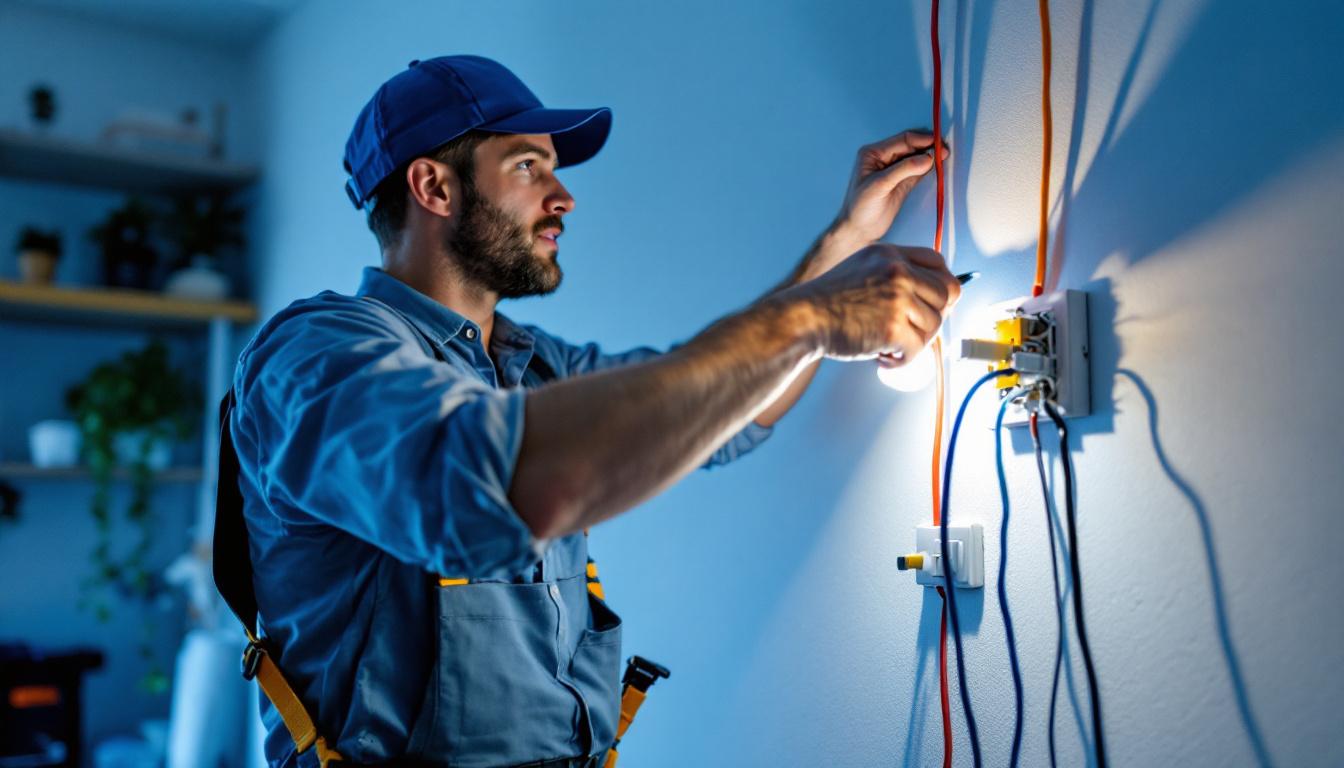
As a lighting contractor, mastering the intricacies of three-way light switches is essential for delivering quality installations and ensuring customer satisfaction. This article serves as a comprehensive guide, providing valuable resources and insights into the world of three-way switches, their functionality, and best practices for installation.
Three-way light switches are unique in that they allow control of a single light fixture from two different locations. This feature is particularly useful in larger spaces, hallways, or staircases, where accessing a single switch from multiple points enhances convenience and safety. Imagine walking into a dimly lit hallway and having the ability to turn on the lights from either end without having to walk all the way to the switch first. This not only saves time but also reduces the risk of accidents in poorly lit areas.
Unlike standard single-pole switches, which have two terminals, three-way switches come with three terminals: two for the traveler wires and one for the common wire. Understanding the wiring configuration is crucial for proper installation and functionality. The traveler wires allow the switches to communicate with each other, enabling the light to be turned on or off from either location. This intricate design is what makes three-way switches an essential component in modern electrical systems.
To effectively work with three-way switches, it is important to familiarize oneself with their components. The primary components include the switch itself, traveler wires, and the common wire. The common wire connects to the power source or the light fixture, while traveler wires connect the two switches. Each component plays a vital role in ensuring that the switches function correctly, and understanding their purpose can simplify troubleshooting and installation processes.
Additionally, there are two types of three-way switches: traditional and smart switches. Traditional switches require physical flipping, while smart switches can be controlled remotely via apps or voice commands. Each type has its own installation nuances and benefits. For instance, smart switches often come with additional features such as dimming capabilities and scheduling options, allowing users to customize their lighting experience to fit their lifestyle. The integration of smart technology into home lighting systems is becoming increasingly popular, providing not just convenience but also energy efficiency.
Three-way switches are commonly used in residential and commercial settings. In homes, they are often installed in stairwells, long hallways, and large rooms with multiple entry points. In commercial spaces, they can enhance safety and accessibility, allowing employees and customers to control lighting easily. For example, in a restaurant, three-way switches can be strategically placed at both the entrance and exit to ensure that patrons can easily turn on or off the lights without disrupting the ambiance.
Understanding the application of three-way switches can help contractors recommend the best solutions for their clients’ needs, ensuring both functionality and aesthetic appeal. Moreover, the versatility of three-way switches allows them to be integrated into various lighting designs, from recessed lighting in modern homes to vintage fixtures in classic settings. This adaptability not only meets practical requirements but also enhances the overall design of a space, making it essential for both homeowners and designers to consider the strategic placement of these switches in their projects.
Installing three-way light switches requires precision and adherence to safety standards. Following best practices not only ensures a successful installation but also minimizes the risk of electrical hazards.
Before beginning the installation, it is essential to turn off the power at the circuit breaker. This step cannot be overstated, as working with live wires poses significant risks. Once the power is off, contractors can proceed with the installation process. Additionally, it is advisable to use a voltage tester to confirm that the power is indeed off before touching any wires. This extra precaution can prevent potential accidents and ensure a safer working environment.
The wiring configuration is the cornerstone of a successful three-way switch installation. The first step is to identify the common, traveler, and ground wires. The common wire is typically black, while the traveler wires can be red and black or any other color that distinguishes them from the common wire. Understanding the function of each wire is crucial, as improper connections can lead to malfunctioning switches or even electrical fires.
When connecting the switches, the common wire from the power source should be connected to the common terminal of the first switch. The traveler wires should then be connected to the traveler terminals on both switches. This configuration allows for seamless operation of the light fixture from either switch location. Furthermore, it is important to ensure that the wire connections are secure and that no exposed copper is showing, as this can lead to shorts or other electrical issues. Using wire nuts or electrical tape can help provide additional insulation and security.
After completing the wiring, it is crucial to test the installation before securing the switches in place. Turn the power back on at the circuit breaker and test the switches to ensure they are functioning correctly. Both switches should be able to turn the light on and off independently. Observing the behavior of the light during this test can provide insights into the integrity of the installation; for instance, if the light flickers or does not respond, it may indicate a loose connection or incorrect wiring.
If the switches do not work as intended, double-check the wiring configuration for any errors. It is better to troubleshoot at this stage than to wait until the switches are fully installed and secured. Additionally, consider labeling the wires during installation to simplify future troubleshooting or modifications. This practice can save time and effort down the line, especially in complex setups where multiple circuits may be involved. Keeping a record of the wiring configuration can also be beneficial for anyone who may need to work on the system in the future.
Having the right tools and equipment is vital for any lighting contractor. The following tools are essential for installing three-way switches effectively:
A standard toolkit should include a screwdriver, wire stripper, and voltage tester. A screwdriver is necessary for securing the switches and covering plates, while a wire stripper is essential for preparing wires for connection.
A voltage tester is a critical safety tool that allows contractors to confirm that the power is off before beginning work. This simple step can prevent accidents and ensure a safe working environment.
For more complex installations, contractors may benefit from advanced equipment such as multimeters and wire tracers. Multimeters can measure voltage, current, and resistance, helping diagnose any electrical issues that may arise during installation.
Wire tracers are particularly useful for identifying existing wiring configurations in older homes, where the layout may not be straightforward. These tools can save time and reduce the risk of errors during installation.
Even experienced contractors may face challenges when installing three-way switches. Understanding common issues and their solutions can help streamline the installation process and improve overall efficiency.
One of the most common challenges is confusion regarding the wiring configuration. It is easy to mix up traveler and common wires, especially in older homes where wiring may not follow standard color codes.
To mitigate this challenge, contractors should take the time to label wires during disassembly and refer to wiring diagrams. Having a clear understanding of the wiring layout can prevent costly mistakes and ensure a smooth installation process.
Another challenge arises when dealing with different types of switches. Not all three-way switches are compatible with each other, particularly when mixing traditional and smart switches.
To avoid compatibility issues, contractors should carefully read the manufacturer’s specifications and ensure that the switches being used are designed to work together. This attention to detail can save time and prevent headaches during installation.
Staying updated on the latest trends and technologies in lighting is crucial for any contractor. Fortunately, there are numerous resources available for continued learning and professional development.
Many organizations offer online courses and webinars focused on electrical installations, including three-way switches. These courses can provide valuable insights into new techniques, safety standards, and emerging technologies in the lighting industry.
Participating in these educational opportunities can enhance a contractor’s skills and knowledge, ultimately leading to better service for clients.
Reading industry publications and blogs can keep contractors informed about the latest trends and best practices. Many lighting industry experts share their insights and experiences through articles and posts, providing practical tips and advice.
Subscribing to relevant publications and following industry leaders on social media can help contractors stay connected and informed about developments in the field.
Mastering three-way light switches is an essential skill for lighting contractors. By understanding their functionality, adhering to best practices during installation, and utilizing the right tools and resources, contractors can deliver high-quality work that meets client expectations.
Continued education and staying informed about industry trends will further enhance a contractor’s expertise, ensuring they remain competitive in a constantly evolving market. With dedication and the right resources, mastering three-way light switches can lead to greater success in the lighting contracting business.
Ready to elevate your lighting projects with the expertise you’ve gained on three-way light switches? Look no further than LumenWholesale for all your lighting needs. Our spec-grade lighting products are designed to meet the highest industry standards, ensuring you deliver exceptional results every time. Take advantage of our unbeatable wholesale prices and free shipping on bulk orders to get the best value for your investment. Wholesale Lighting at the Best Value is just a click away. Make LumenWholesale your go-to source for premium lighting solutions today.

Discover the essential insights lighting contractors need with our comprehensive guide to UV light sterilizers.

Discover why T5 light fixtures are becoming a top choice for lighting contractors.

Discover the essential checklist for lighting contractors focusing on ceiling lights with bulbs.

Discover how Type T halogen lamps boost lighting contractors’ efficiency, safety, and cost savings. Learn key benefits and optimize your projects today!.